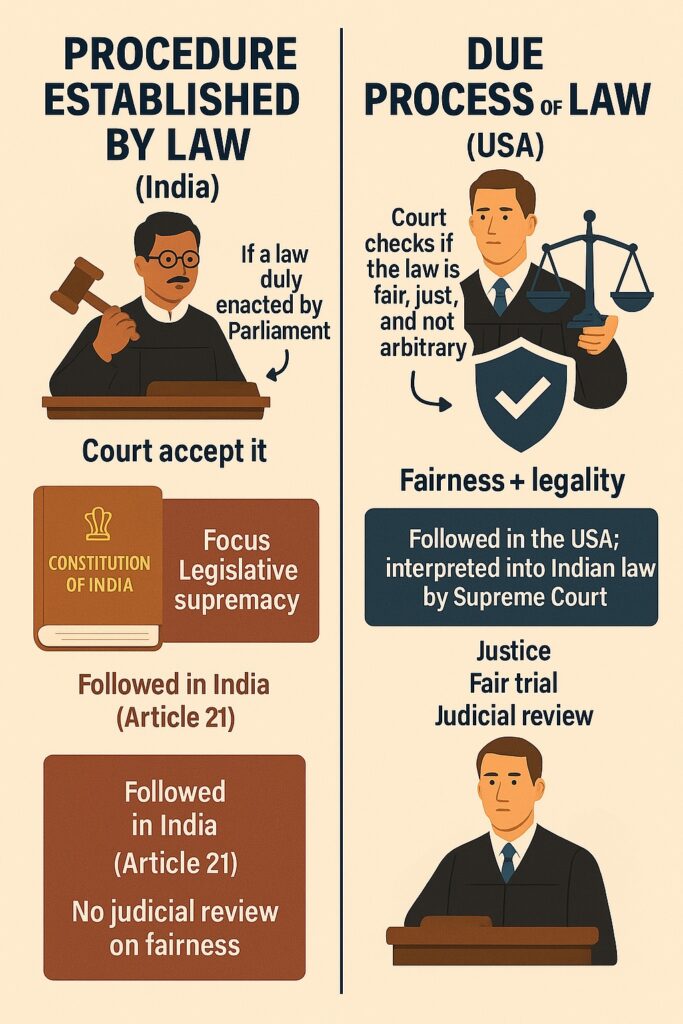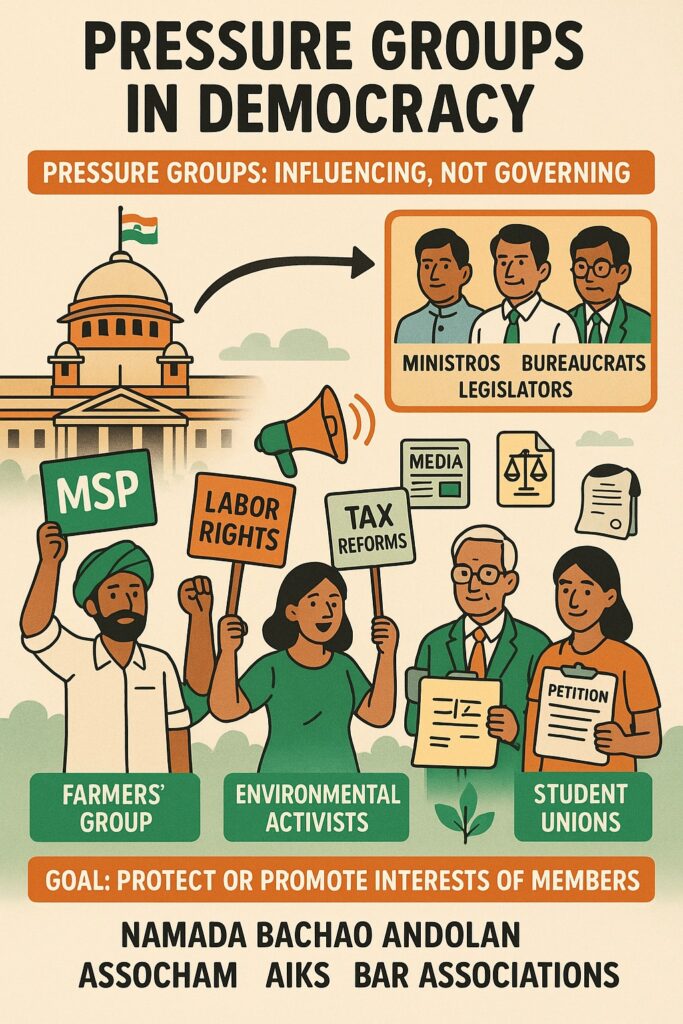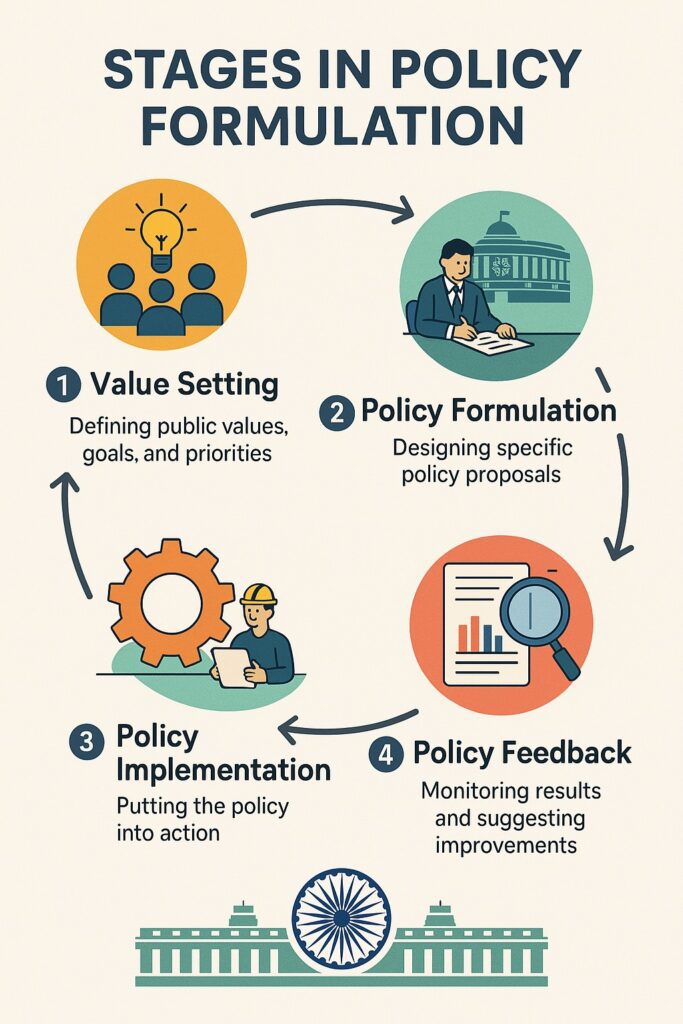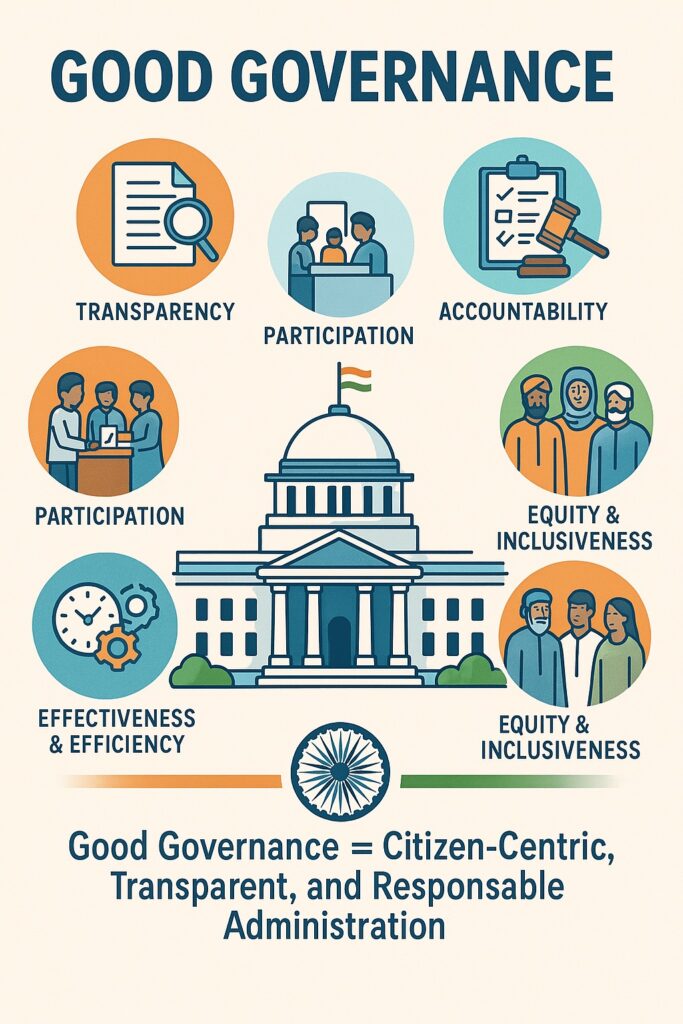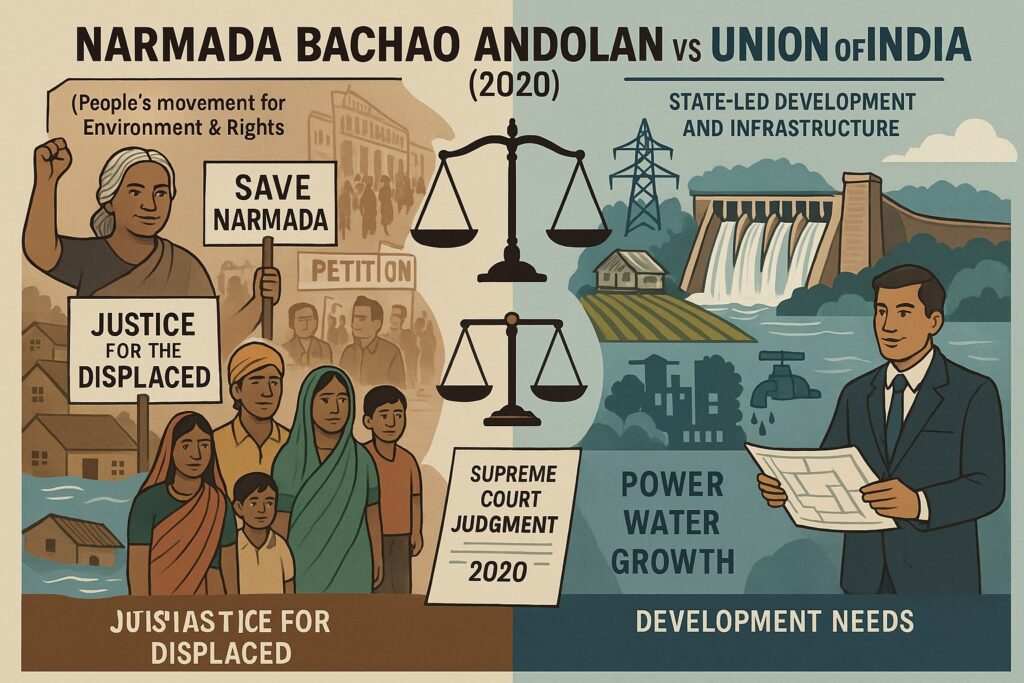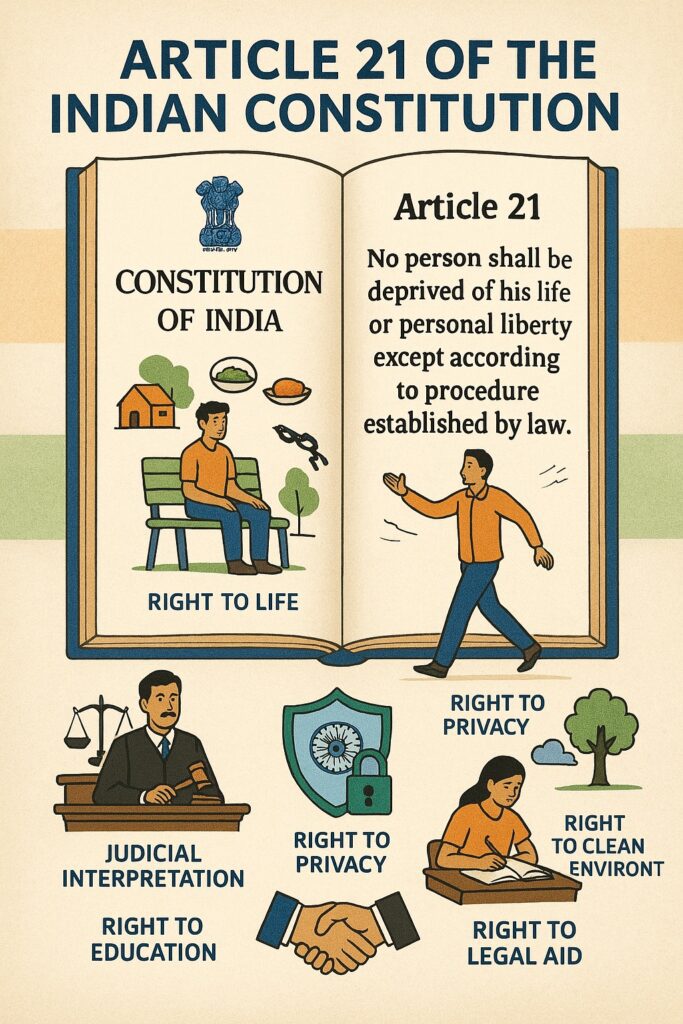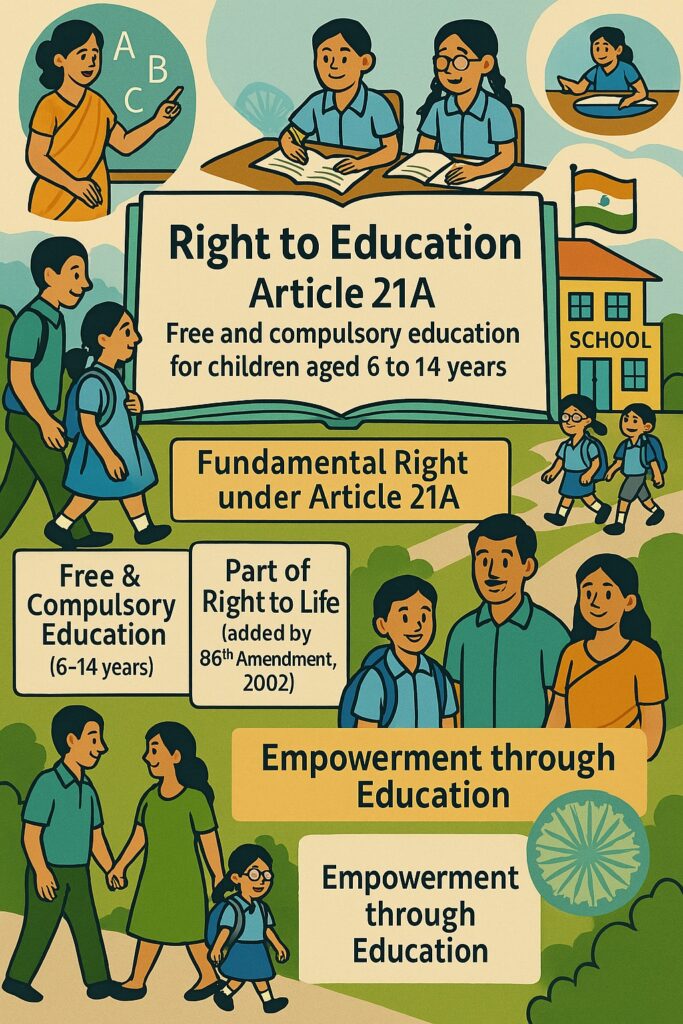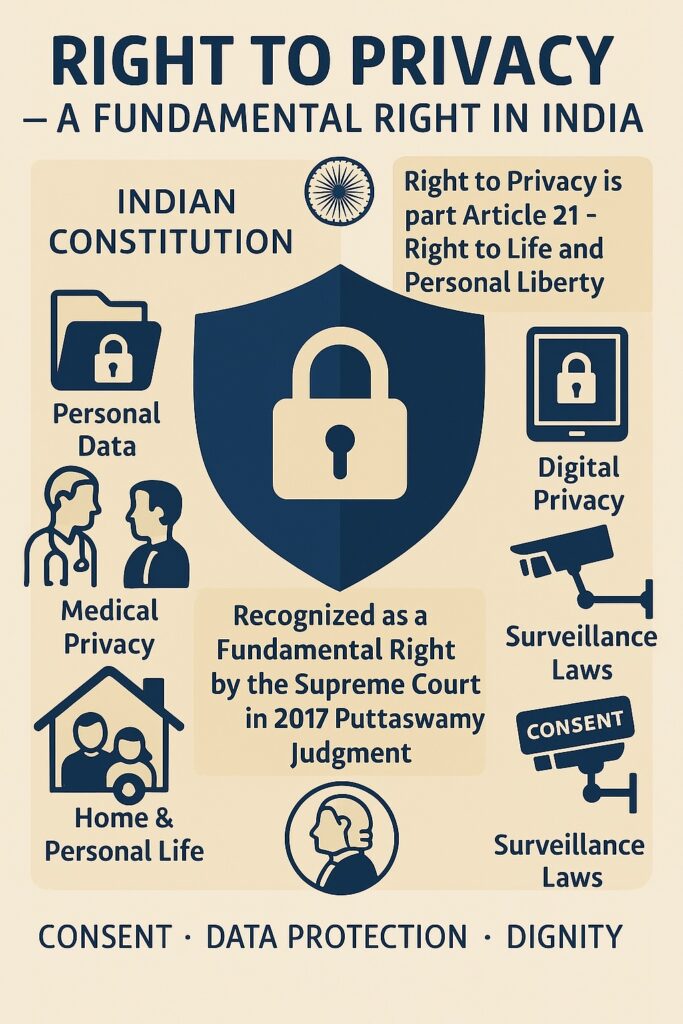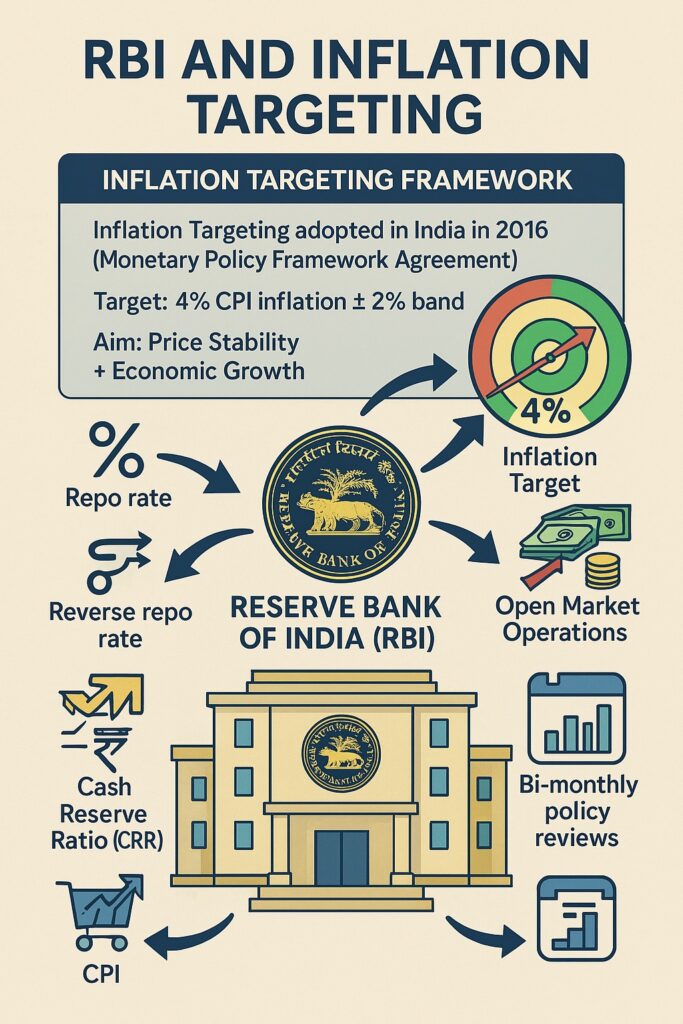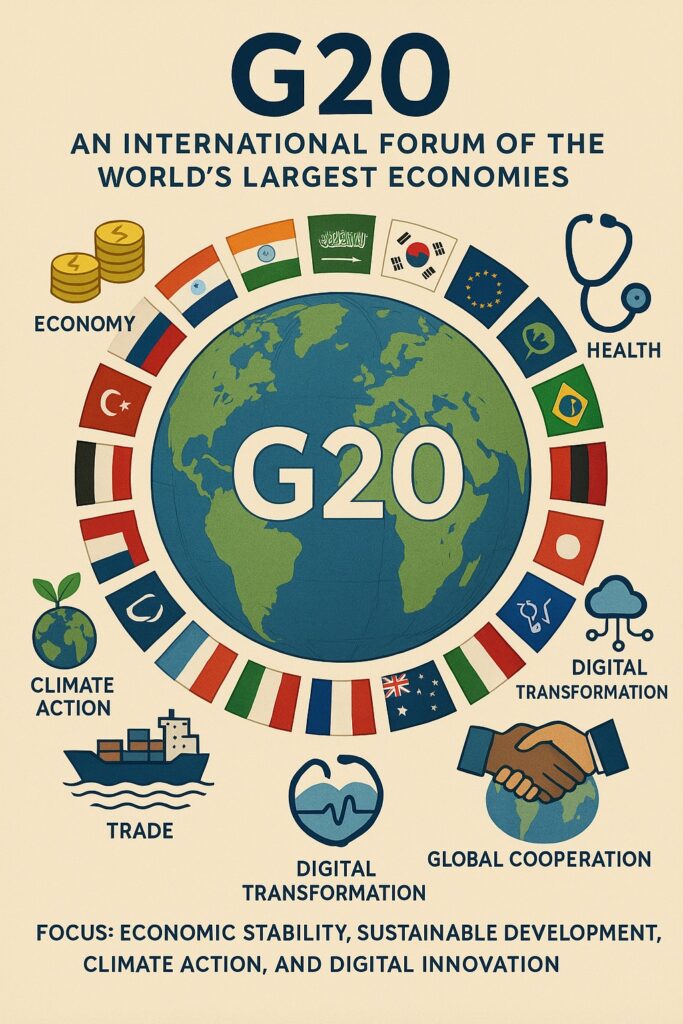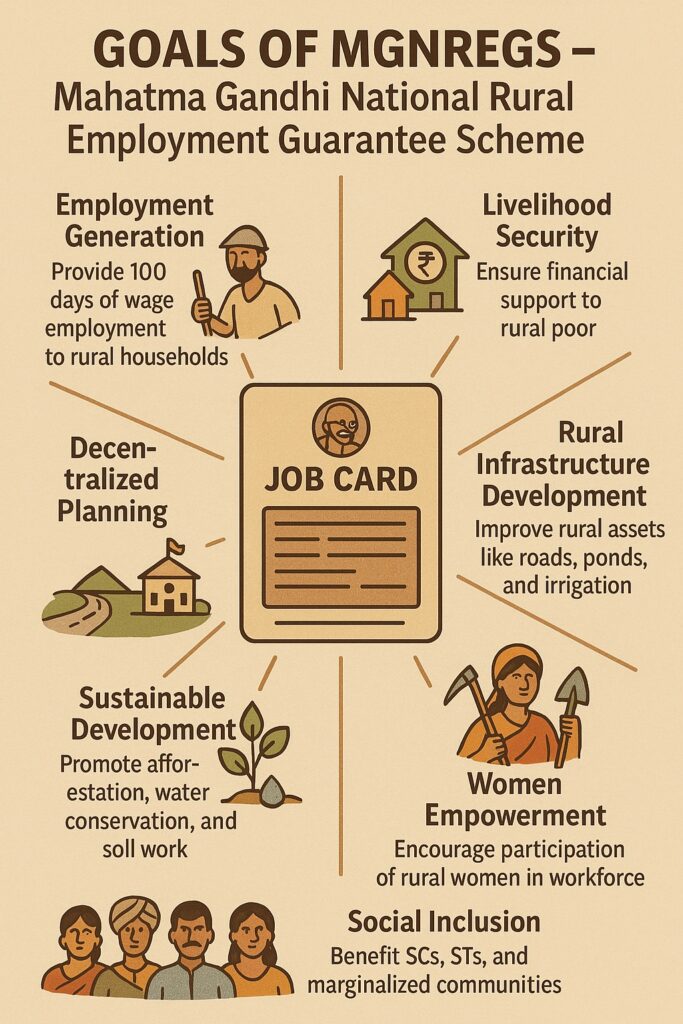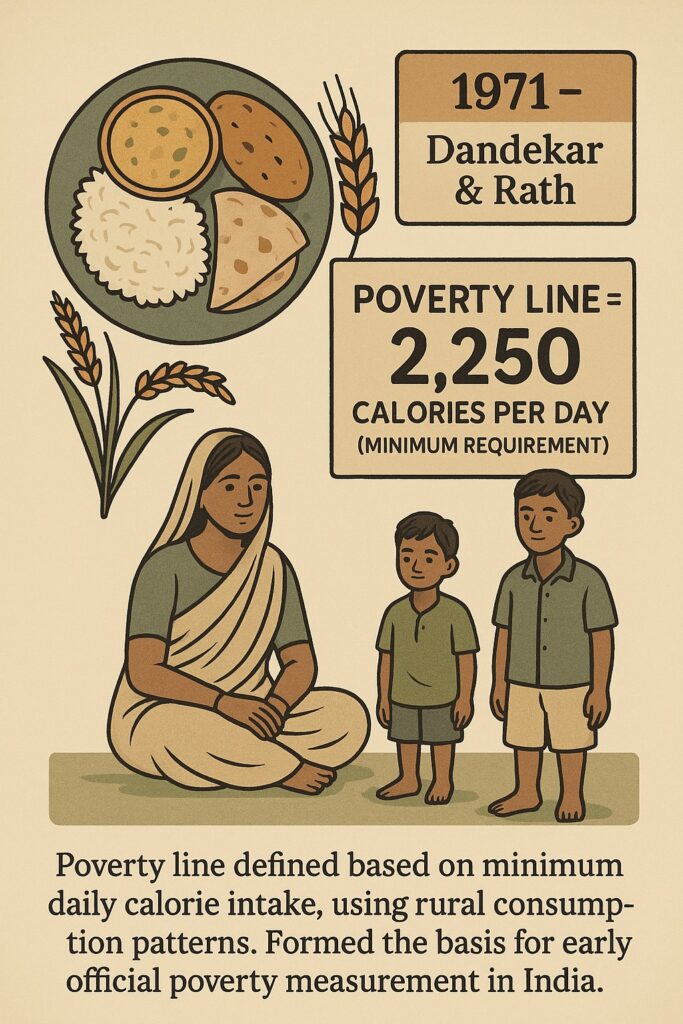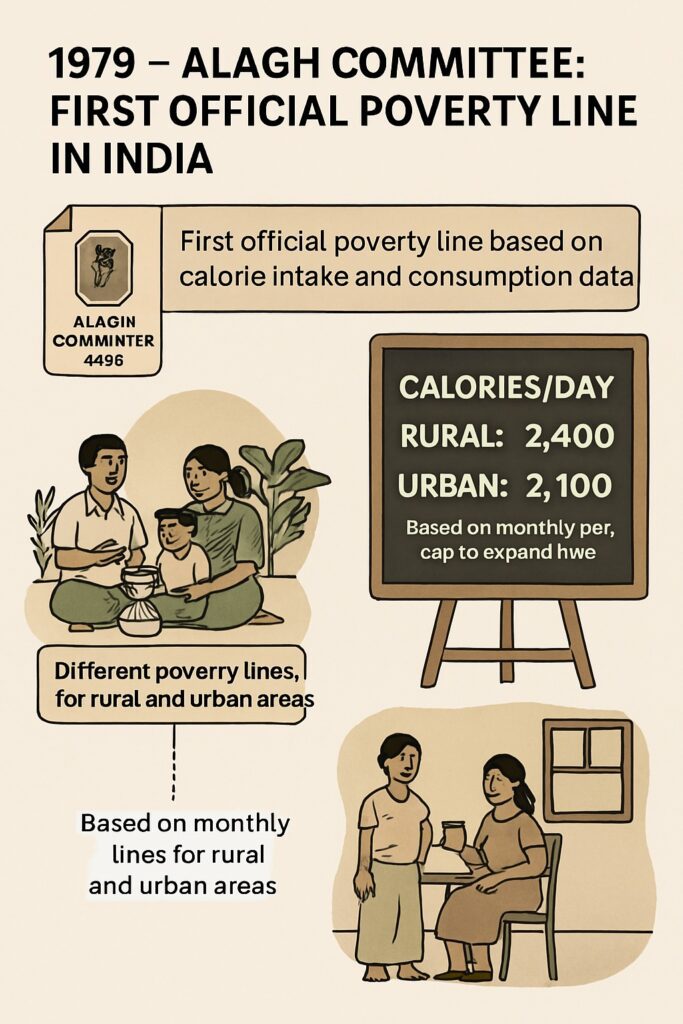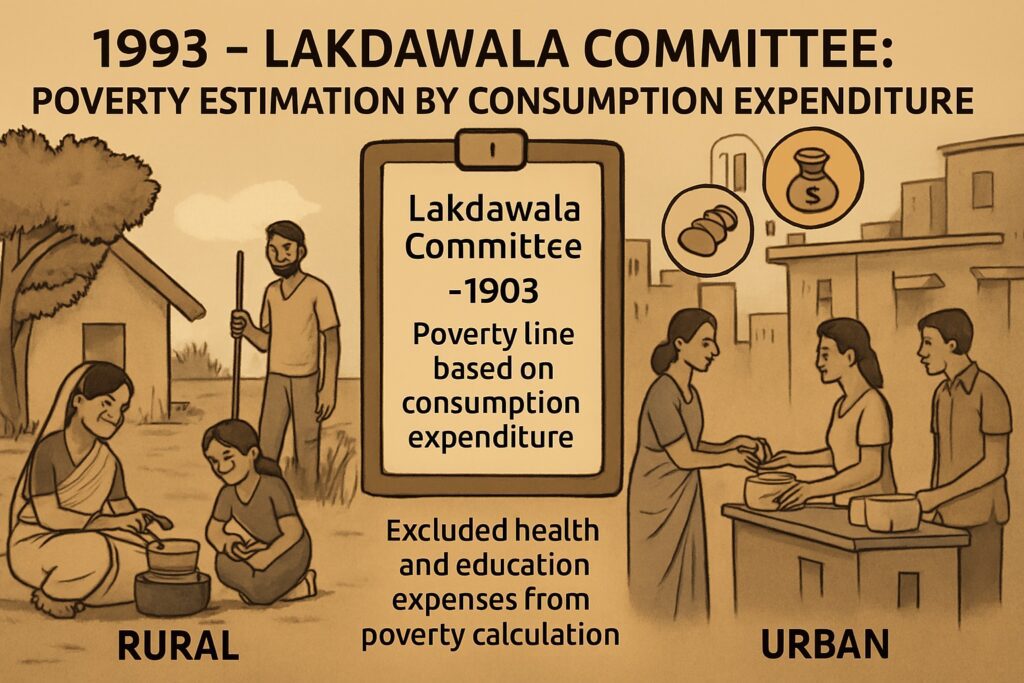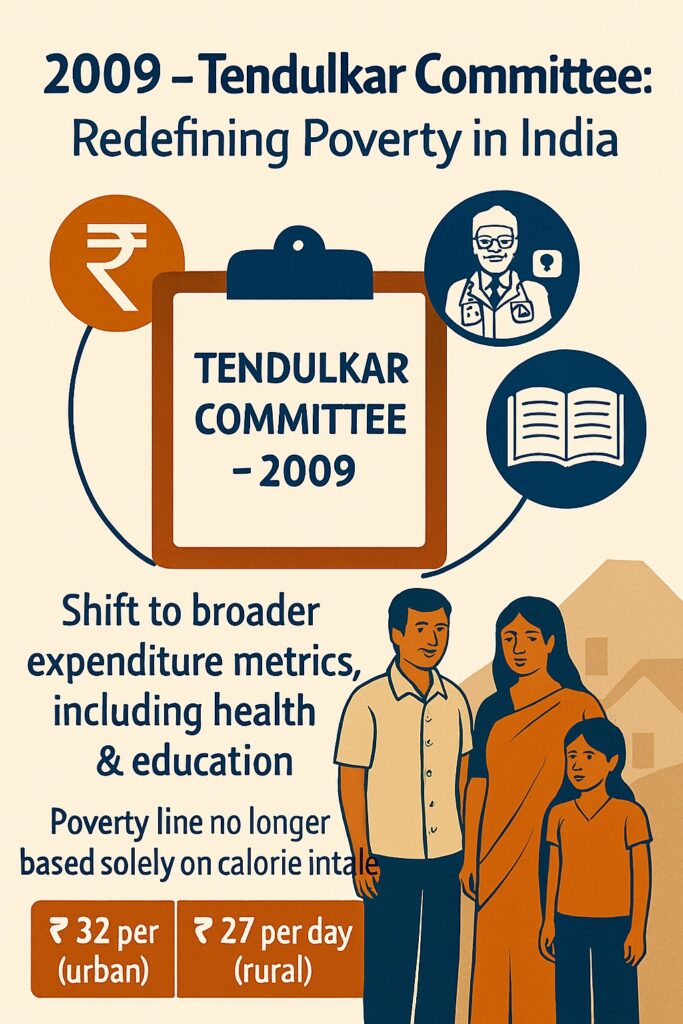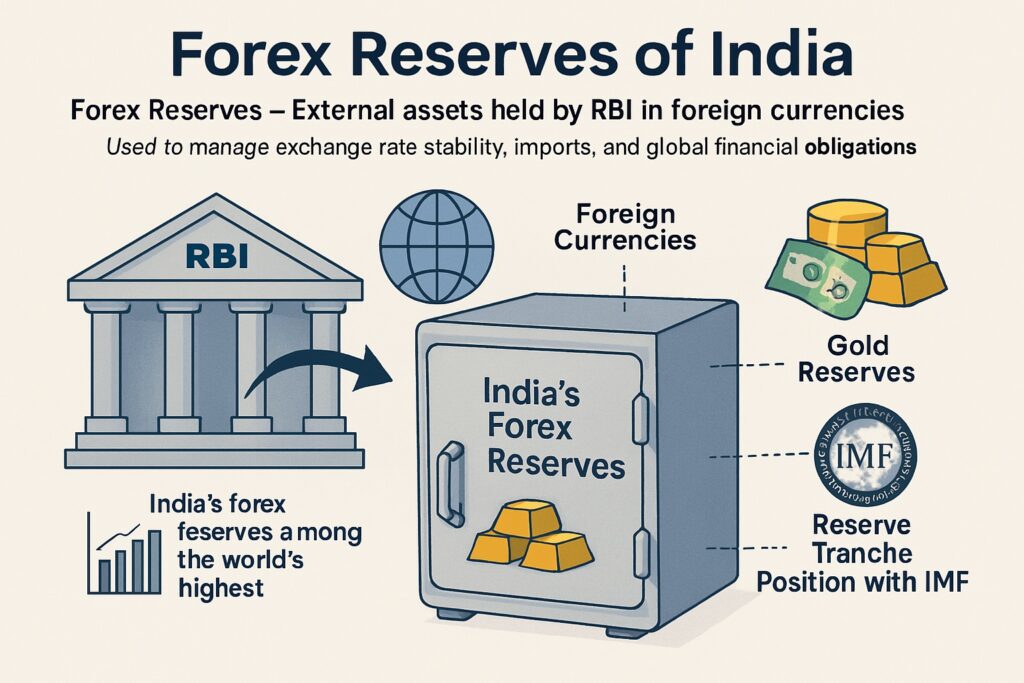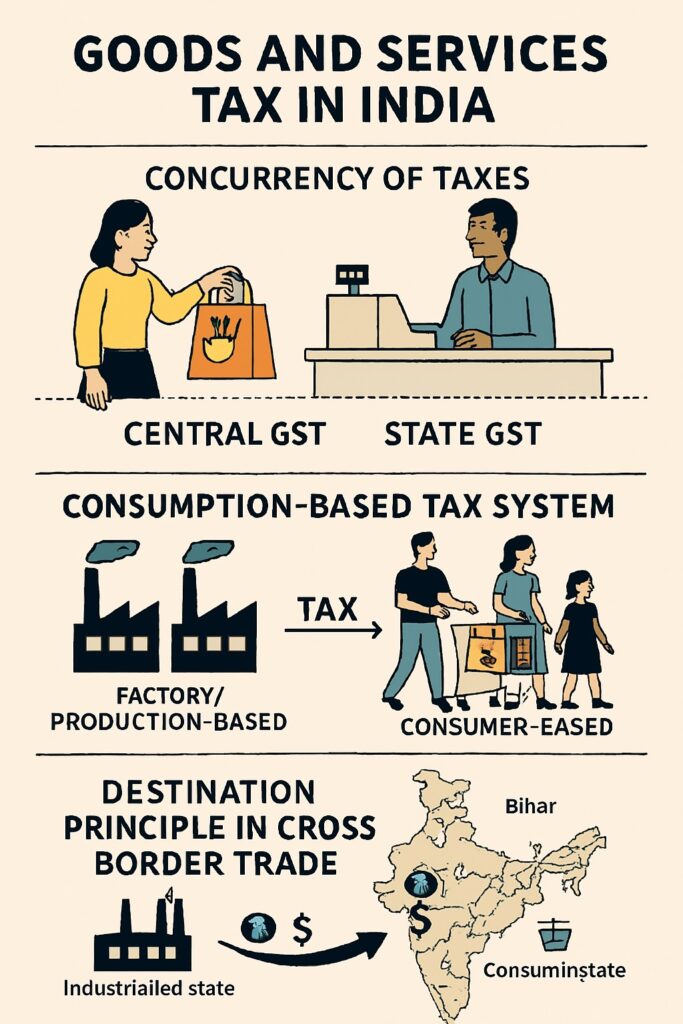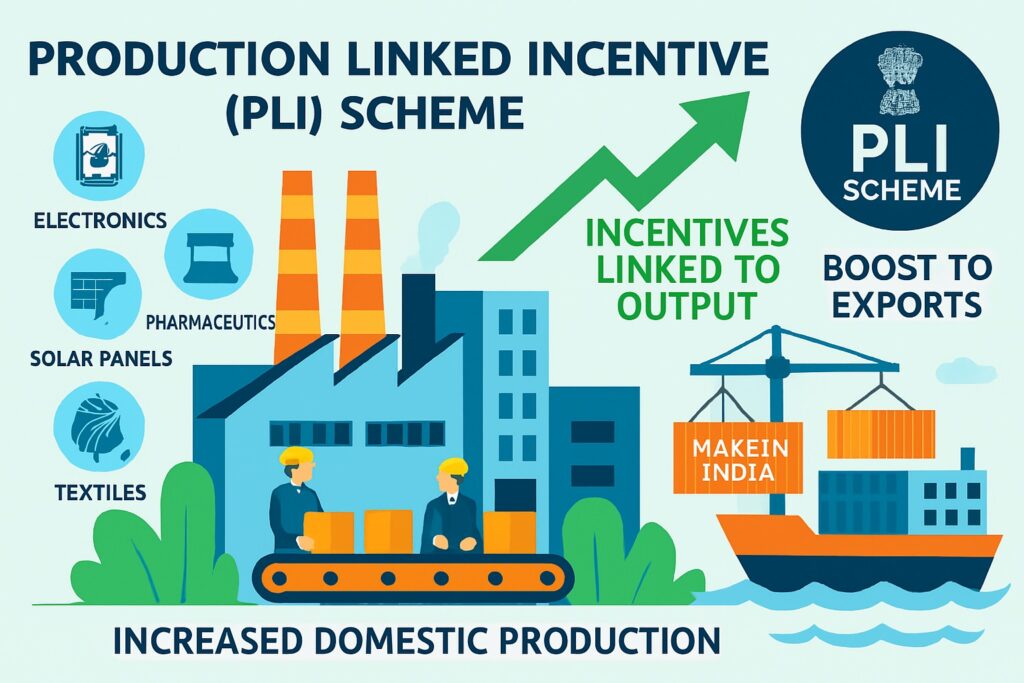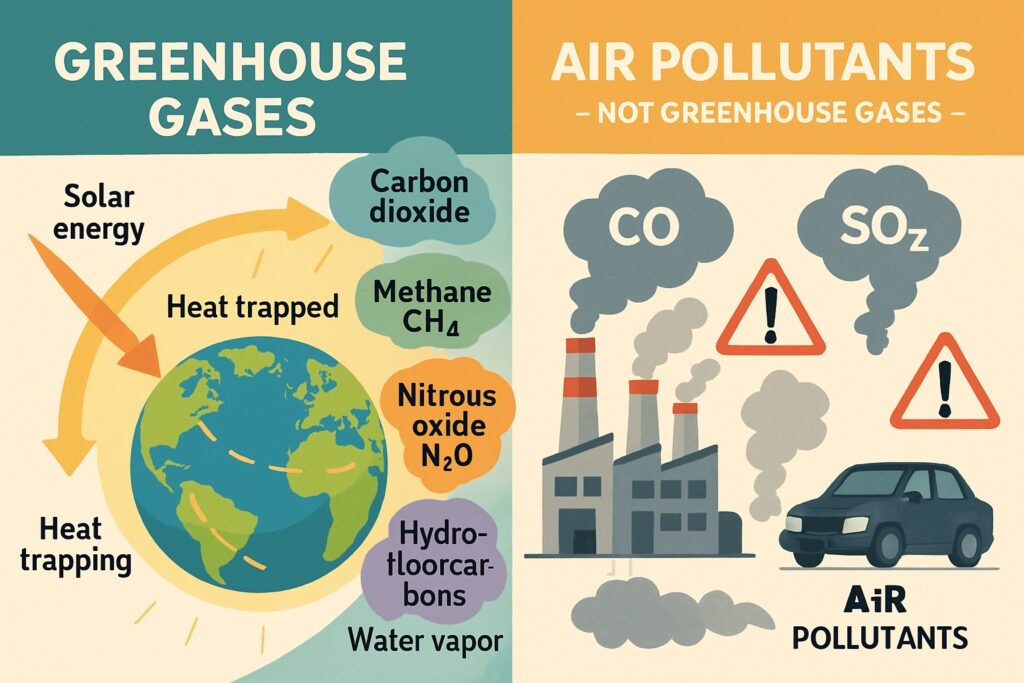Download OPSC OAS 2023 Prelims Question Paper
1. Which of the following statements are correct in respect of the Election Commission of India?
- It is an autonomous Legal Body.
- Part XV of the Indian Constitution deals with the Elections and the Election Commission.
- The Election Commission was established on January 25, 1950.
- Article 328 provides a bar on the interference of Courts in electoral matters.
(A) 2 and 3
(B) 1 and 4
(C) 3 and 4
(D) 2 and 3
Ans: (A)
Solution: Statements 2 and 3 are correct. Part XV of the Indian Constitution deals with Elections and the Election Commission (Statement 2). The Election Commission of India was established on January 25, 1950 (Statement 3). Statement 1 is correct as the Election Commission of India is an autonomous constitutional authority, but Statement 4 is incorrect because Article 329, not Article 328, provides a bar on the interference of courts in electoral matters.
Read: OPSC Notes
2. Which of the following Committees recommended for the creation of ‘Nyaya Panchayats’ at the village level?
(A) L.M. Singhvi Committee
(B) G.V.K. Rao Committee
(C) Mohan Kanda Committee
(D) Ashok Mehta Committee
Ans: (D)
Solution: The Ashok Mehta Committee recommended the creation of ‘Nyaya Panchayats’ at the village level. This committee aimed to revitalize the Panchayati Raj system and suggested a two-tier structure instead of the existing three-tier system.
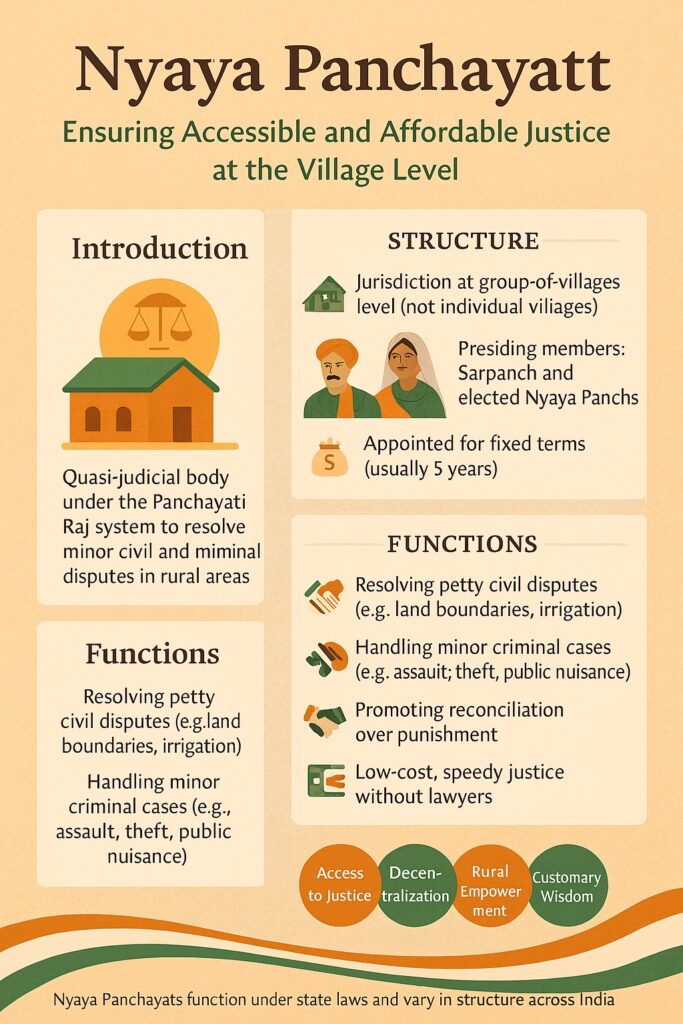
3. Which of the following statements are correct in respect of ‘Attorney General of India’?
- Attorney General of India is a part of Indian Judiciary.
- Attorney General of India is appointed by the President on the advice of the Chief Justice of India.
- The term of office of the Attorney General of India is not fixed by the Constitution.
- Attorney General of India has the right to take part in the proceedings of both Houses of Parliament.
(A) 1, 2, and 4
(B) 2 and 3
(C) 1 and 3
(D) 3 and 4
Ans: (D)
Solution: Statements 3 and 4 are correct. The term of office of the Attorney General of India is not fixed by the Constitution (Statement 3). The Attorney General of India has the right to take part in the proceedings of both Houses of Parliament but without the right to vote (Statement 4). Statement 1 is incorrect because the Attorney General is part of the executive, not the judiciary. Statement 2 is incorrect because the Attorney General is appointed by the President but not on the advice of the Chief Justice of India.
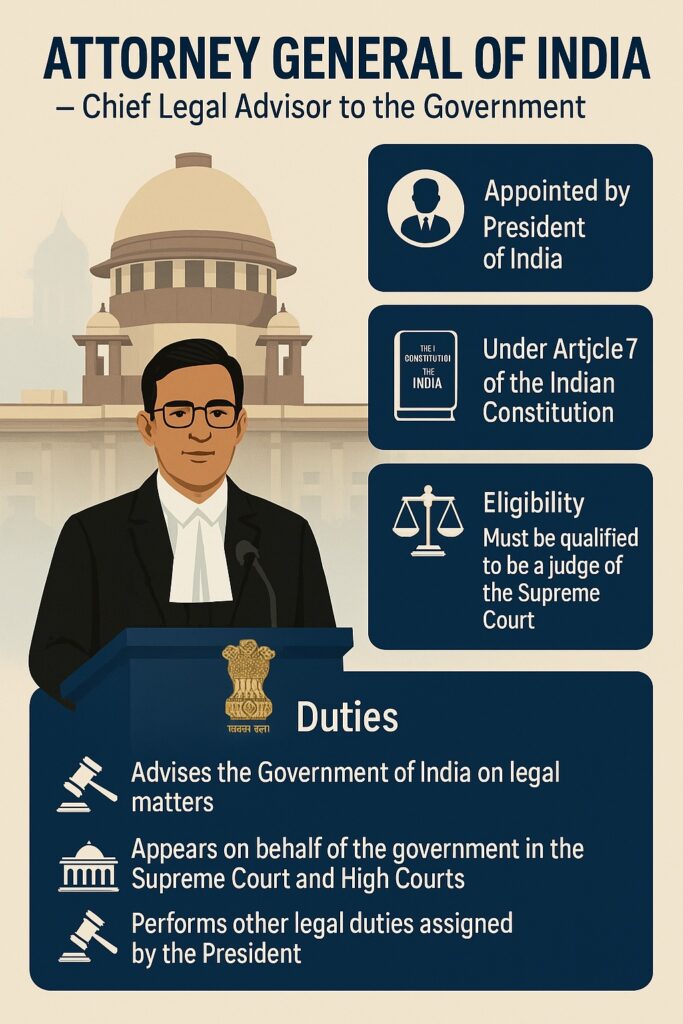
4 Which of the following statements are correct in respect of Bills introduced in Parliament?
- If a Government Bill is rejected by the House in Parliament it amounts to a ‘vote of confidence’ in the Government.
- The Government’s Bill introduction in the House necessitates a fifteen-day notice.
- The ‘Taxation Laws (Amendment) Bill 2021’ comes under the category of Money Bill.
- The ‘Central Universities (Amendment) Bill 2021’ comes under Ordinary Bill.
(A) 1 and 4
(B) 2 and 3
(C) 3 and 4
(D) 2 and 4
Ans: (C)
Solution: Statements 3 and 4 are correct. The ‘Taxation Laws (Amendment) Bill 2021’ is a Money Bill (Statement 3). The ‘Central Universities (Amendment) Bill 2021’ is an Ordinary Bill (Statement 4). Statement 1 is incorrect because the rejection of a Government Bill does not necessarily amount to a ‘vote of confidence’ in the Government, it can lead to the government seeking a confidence vote separately. Statement 2 is incorrect because there is no mandatory fifteen-day notice period for introducing Government Bills in the House.
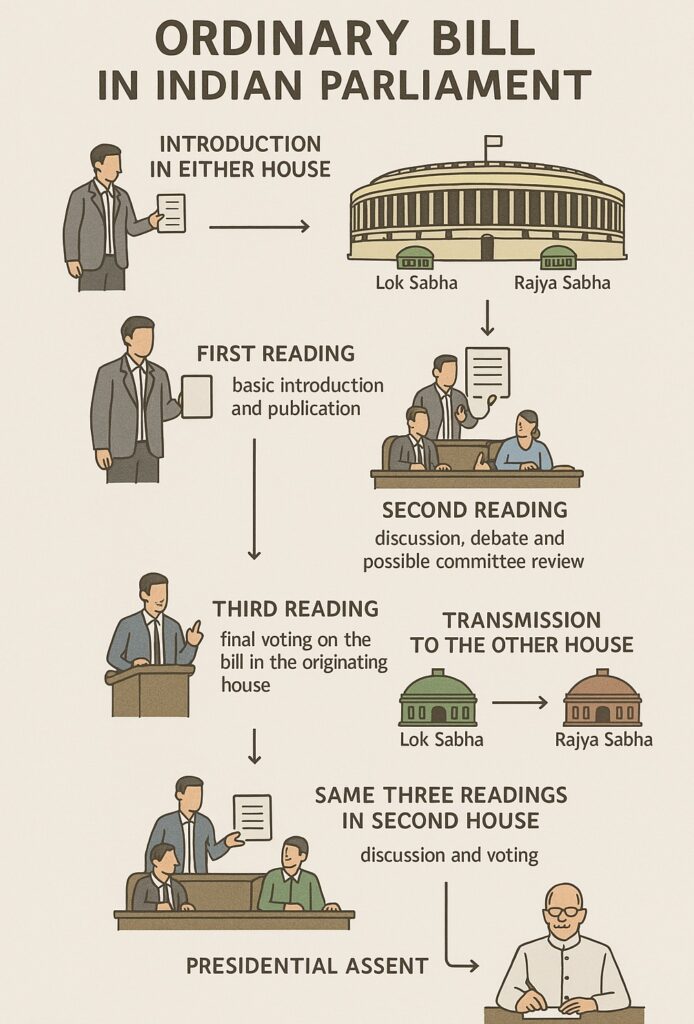
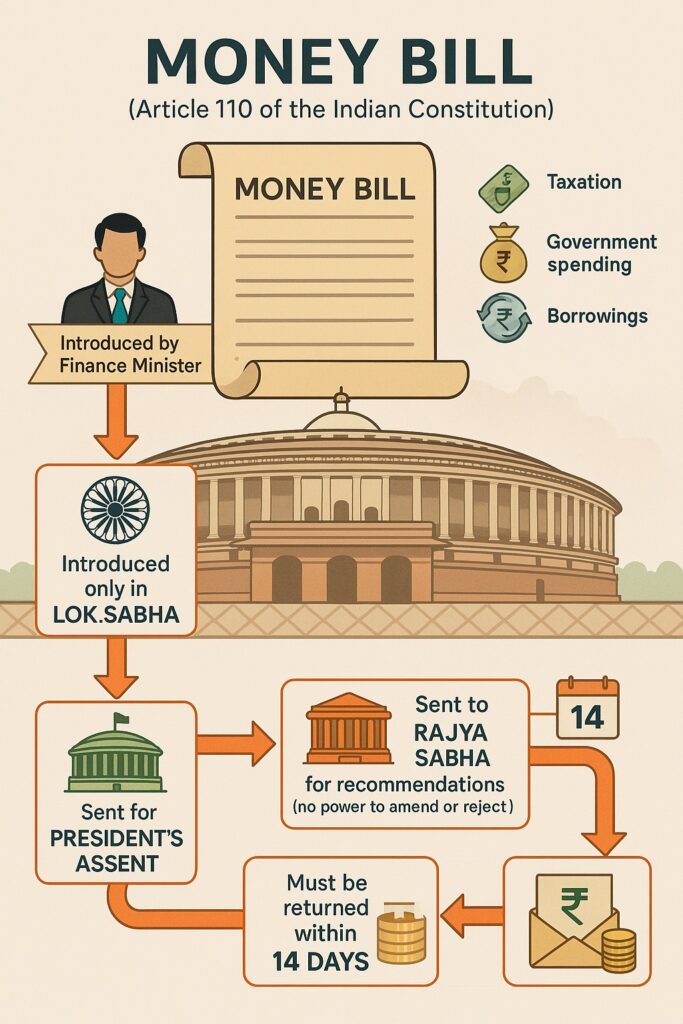
5. Which of the following statements are correct in respect of “Types of Majority in Parliament”?
- Absolute Majority: More than 50% of the House’s total strength.
- Simple Majority: The majority of more than 50% of those present and voting.
- Effective Majority: Majority of the House’s effective strength.
- Effective Strength: means total strength excluding the number of vacancies.
- Special Majority: Majority of 2/3 members of the total strength of the House.
(A) 1, 3, 4, and 5
(B) 2, 3, and 5
(C) 2, 3, and 4
(D) 1, 2, 3, and 4
Ans: (D)
Solution: Statements 1, 2, 3, and 4 are correct.
Absolute Majority is more than 50% of the total strength of the House (Statement 1). Simple Majority is the majority of more than 50% of those present and voting (Statement 2). Effective Majority is the majority of the House’s effective strength, which excludes vacancies (Statement 3). Effective Strength means the total strength excluding the number of vacancies (Statement 4). Statement 5 is incorrect as Special Majority often refers to a majority of 2/3 members present and voting.
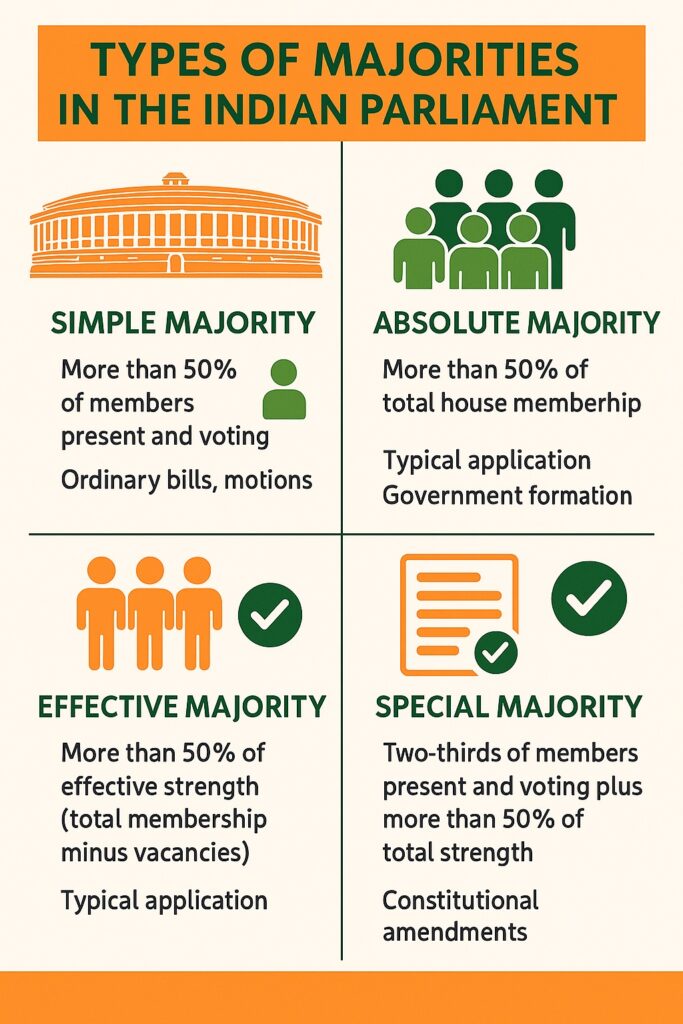
6. Which of the following statements are correct in respect of ‘Sittings of Parliament’?
- In the year 1955, a Lok Sabha Committee had proposed a timetable for parliamentary sessions with three times a year.
- It suggested Budget Session from February 1 to May 7.
- It suggested Monsoon Session from July 1 to September 10.
- It suggested Winter Session from November 15 to December 15.
(A) 1 and 4
(B) 2 and 3
(C) 1 and 2
(D) 3 and 4
Ans: (A)
Explanation: In 1955, a Lok Sabha Committee indeed recommended a structured timetable proposing three parliamentary sessions a year.
- It suggested the Budget Session from February 1 to May 7 — this aligns with what was proposed.
- The Monsoon Session was recommended from July 15 to September 15, not July 1 to September 10.
- The Winter Session was proposed for November 15 to December 22, not ending on December 15.
So, only statements 1 and 2 are correct.
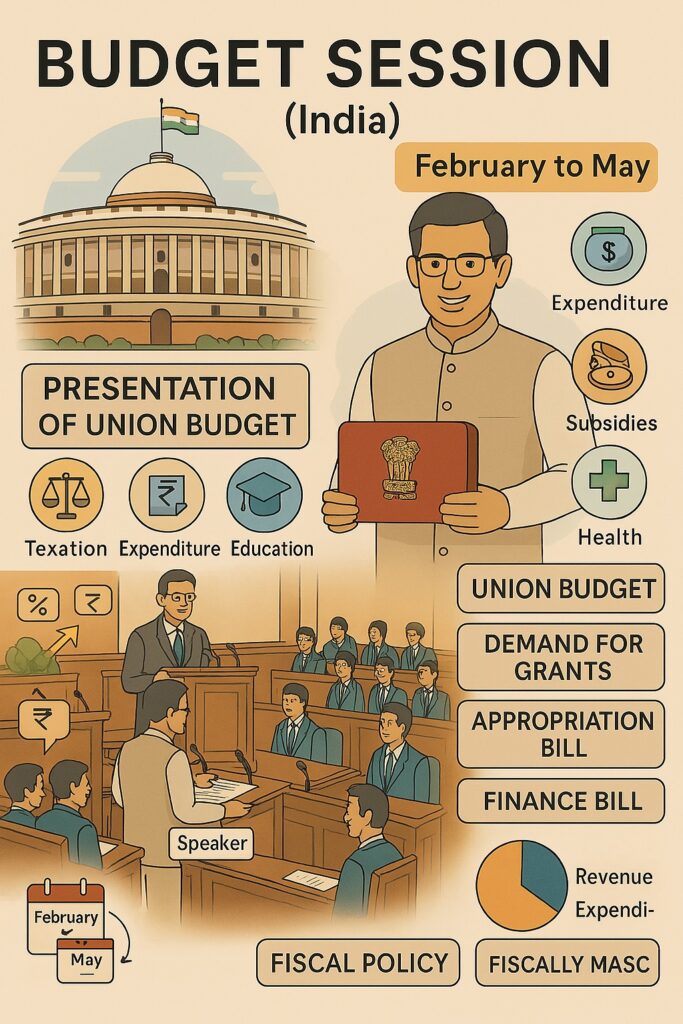
| List I | List II |
|---|---|
| a. Faulting | 1. Yardangs |
| b. Wave erosion | 2. Kettle Hole |
| c. Ice Scouring | 3. Escarpment |
| d. Wind erosion | 4. Stacks |
Codes:
| a | b | c | d | |
|---|---|---|---|---|
| (a) | 3 | 4 | 1 | 2 |
| (b) | 4 | 3 | 1 | 2 |
| (c) | 3 | 4 | 2 | 1 |
Answer: (c) 3 4 2 1
Explanation:
Faulting: Faulting can create features such as escarpments, which are steep slopes or cliffs resulting from displacement along a fault.
Wave erosion: Wave erosion can create features such as stacks, which are vertical columns of rock in the sea near a coast, formed by wave erosion.
Ice Scouring: Ice scouring can create features such as kettle holes, which are depressions formed by retreating glaciers or draining floodwaters.
Wind erosion: Wind erosion can create features such as yardangs, which are streamlined, wind-eroded ridges found in desert regions.
47.Carefully read the following
Assertion (A): Scandinavian countries have a regressive age-sex population structure.
Reason (R): The population growth rate is negative in these countries.
For selecting the correct answer, use the following code:
(a) Both assertion (A) and reason (R) are true and Reason (R) is a correct explanation of Assertion (A).
(b) Both assertion (A) and Reason (R) are true but Reason (R) is not a correct explanation of Assertion (A).
(c) Assertion (A) is true and Reason (R) is false.
(d) Assertion (A) is false and Reason (R) is true.
Answer: (c) Assertion (A) is true and Reason (R) is false.
Explanation: Scandinavian countries are known to have a regressive age-sex population structure, which means they have a larger proportion of older individuals compared to younger individuals. This is typically due to low birth rates and higher life expectancy, resulting in an aging population.
The population growth rate is low in these countries further supports this structure. However, the rate is not negative.
48. Match List – II and List II and select the correct answer using the code given below:
| List – I (Major Cultural Region of the World) | List – II (Inhabitants) |
|---|---|
| a. Arctic Region | 1. Eskimos |
| b. Desert | 4. Caravan Region |
| c. Latin American Region | 2. The Indians, Negroes, and Immigrants |
| d. Pacific Ocean | 3. Samoans, Tahitian, Tongan, etc. |
Codes:
| a | b | c | d |
|---|---|---|---|
| 1 | 4 | 2 | 3 |
| 4 | 1 | 3 | 2 |
| 1 | 3 | 2 | 4 |
| 4 | 2 | 3 | 1 |
Answer: (b) 1 4 2 3
Explanation:
- Arctic Region corresponds to Eskimos, who are indigenous people inhabiting the Arctic regions.
- Desert corresponds to Caravan Region, as caravans are commonly associated with desert regions where they travel for trade.
- Latin American Region corresponds to The Indians, Negroes, and Immigrants, reflecting the diverse population of Latin America.
- Pacific Ocean corresponds to Samoans, Tahitian, Tongan, etc., which are groups of people living in the Pacific islands.
49. Match List – I with List – II according to Koppen’s Climatic classification system and select the correct answer from the codes given:
| List I (Climate types) | List II (Characteristics) |
|---|---|
| a. Af | i. Humid Tropical |
| b. Aw | ii. Tropical Humid and Dry Climate |
| c. Am | iii. Monsoon climate |
| d. As | iv. Dry Summers |
Codes:
| a | b | c | d |
|---|---|---|---|
| i | ii | iii | iv |
| ii | iii | i | iv |
| iii | i | ii | iv |
| iv | ii | i | iii |
Answer: (a)
Explanation:
- a. Af corresponds to i. Humid Tropical, which is characterized by consistent high temperatures and significant rainfall throughout the year.
- b. Aw corresponds to ii. Tropical Humid and Dry Climate, which is characterized by distinct wet and dry seasons.
- c. Am corresponds to iii. Monsoon climate, which has a short dry season with a heavy monsoon rainfall season.
- d. As corresponds to iv. Dry Summers, which are typically found in climates with dry summers and wet winters.
50. Given below are two statements, one labelled as Assertion (A) and the other labelled as Reason (R).
Select your answer from the codes given below:
Assertion (A): The Peru desert is recognised as a cold desert.
Reason (R): The temperature of the Humboldt current plays a dominant role in controlling the surface atmospheric conditions of the coastal areas.
Select your answer from the codes given below:
Explanation:
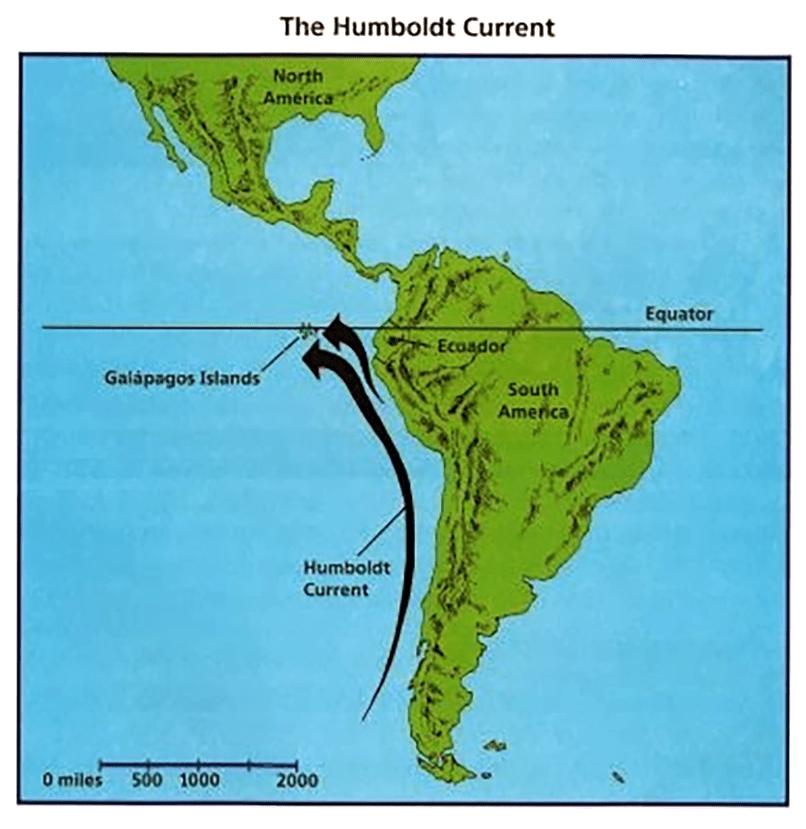
Assertion (A) is true: The Peru desert, also known as the Atacama Desert, is recognized as a cold desert due to its extremely low temperatures.
Reason (R) is true: The Humboldt Current, which is a cold ocean current, significantly influences the surface atmospheric conditions of the coastal areas, contributing to the cold temperatures of the Peru desert.
Therefore, both Assertion (A) and Reason (R) are true, and Reason (R) is a correct explanation of Assertion (A).
51. Match the following with respect to the occurrence of races in List – II to the type of Races in list – I:
| List – I (Races) | List – II (Area of Existence) |
|---|---|
| a. The Turko Iranian | 1. Rajasthan and Punjab |
| b. The Indo Aryan | 2. Odisha and Assam |
| c. The Scytho Dravidian | 3. West India (Gujarat to Karnataka) |
| d. The Mongolo – Dravidian | 4. North Western Frontier Agency |
Codes:
Answer: (a)
Explanation:
- The Turko Iranian race is found in the North Western Frontier Agency.
- The Indo Aryan race is prevalent in Rajasthan and Punjab.
- The Scytho Dravidian race is found in West India, from Gujarat to Karnataka.
- The Mongolo –Dravidian race exists in Odisha and Assam.
52. India is an agricultural country, where most of the population is directly or indirectly involved in this sector. Regarding agriculture in India, which one of the following statements is/are not correct?
- Bajra is a kharif crop, which requires 25°C – 31°C temperature and 40 – 50 cm rainfall.
- Cotton is categorized into three groups: long-staple, medium-staple, and short-staple.
- Currently, India accounts for about 50% of the world’s total jute production.
- India is the second-largest producer of silk and the largest consumer of silk in the world.
Select the correct answer using the codes given below:
Answer: (d) only 4
Explanation: India is both the world’s second-largest silk producer and its largest consumer.
Bajra is a staple food crop grown in arid and semi arid regions and requires a temperature condition that ranges between 20 to 25 degree centigrade.
India is a major producer of jute but does not account for 50% of the world’s production.
53. Match important projects in List – I with the area of implementation in List – II
| List – I (Multipurpose Projects in India) | List – II (Area/ Place of implementation) |
|---|---|
| a. Tungabhadra Multipurpose project | 1. Lower Narmada Valley, Gujarat |
| b. The Sardar Sarovar | 2. Nalgonda District, Telengana |
| c. Nagarjuna | 3. Andhra Pradesh and Karnataka |
| d. Bhakra Nangal Project | 4. Punjab, Haryana and Rajasthan |
Codes:
Answer: (c)
Explanation:
- Tungabhadra Multipurpose project is in Andhra Pradesh and Karnataka.
- The Sardar Sarovar project is in the lower Narmada Valley, Gujarat.
- Nagarjuna is in Nalgonda District, Telangana.
- Bhakra Nangal Project is in Punjab, Haryana, and Rajasthan.
54. Mountain Passes and States
Among the following options which mountain pass doesn’t belong to the correct state?
Answer: (b) Aghil Pass → Uttarakhand
Explanation: Aghil Pass is actually in the Karakoram range near Ladakh, not Uttarakhand.
55. Factors responsible for breaks in the monsoon
Which of the following factors are responsible for breaks in the monsoon?
- Origin of Tropical cyclones in Bay of Bengal
- Erratic behaviour of 2nd equatorial troughs
- Inadequate heating of Tibetan Plateau
- Southern Branch of South West Tropical Jet re-establish over Northern India
Choose the correct options from below:
Answer: (c) I, II and IV
Explanation:
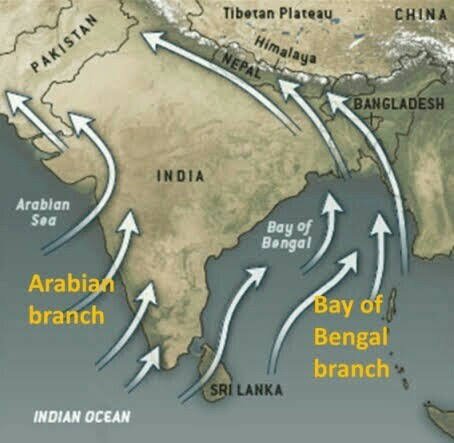
- Origin of Tropical cyclones in the Bay of Bengal can disrupt the normal monsoon patterns.
- Erratic behaviour of 2nd equatorial troughs can cause irregularities in monsoon rains.
- Southern Branch of South West Tropical Jet re-establishing over Northern India can influence monsoon breaks.
Inadequate heating of the Tibetan Plateau is less directly related to breaks in the monsoon.
56. Which of the following river/rivers are exhibiting the antecedent drainage pattern in Odisha?
Answer: (a) The Mahanadi and the Brahmani
Explanation: The Mahanadi and Brahmani rivers are the primary examples of antecedent rivers in Odisha. These rivers have maintained their original courses despite the uplift of the Eastern Ghats.
Antecedent drainage is a type of drainage pattern where a river’s course is established before the uplift of the land it flows through. In other words, the river existed before the land was raised.
How it happens?
- A river is flowing across a flat landscape.
- The land gradually begins to uplift due to tectonic forces.
- The river, instead of changing its course, continues to flow, cutting through the rising land to maintain its original path.
- This results in the formation of deep gorges or valleys as the river erodes its way through the uplifted area.
Examples of rivers with antecedent drainage in Himalaya:
- Indus River
- Brahmaputra River
- Sutlej River
57. Black Earth Soil has been developed in which region of Odisha?
Answer: (c) Anugul – Athamallik and Boudh
Explanation: Black Earth Soil, also known as Regur soil, is commonly found in the Anugul – Athamallik and Boudh regions of Odisha due to its volcanic origin and the presence of decomposed basalt.
58. Match the morphological units of Rolling Uplands (List – I) with the correct river basin (List – II):
| List I (Morphological Units) | List II (Basins Associated) |
|---|---|
| a. The Rajgangpur – Panposh Uplands | 1. Ib Basin |
| b. The Jharsuguda uplands | 2. Northern Tel Basin |
| c. The Balangir – Titlagarh | 3. The Sabari Basin |
| d. The Malkanagiri Uplands | 4. Koel and the Sankh rivers |
Answer: (a)
Explanation:
- The Rajgangpur – Panposh Uplands are associated with the Koel and the Sankh rivers basin.
- The Jharsuguda uplands are associated with the Ib Basin.
- The Balangir – Titlagarh is associated with the Northern Tel Basin.
- The Malkanagiri Uplands are associated with the Sabari Basin.
59. Which of the following is associated with Chilika lake?
- First Indian wetland under the Ramsar Convention.
- Irrawaddy dolphins
- Lacustrine plain
Answer: (d) I, II and III
Explanation: Chilika Lake is associated with all the given points:
- It was the first Indian wetland under the Ramsar Convention.
- It is home to the Irrawaddy dolphins.
- It features a lacustrine plain.

60. Odisha experiences which types of climates according to Koppen’s climatic classification?
Answer: (a) Tropical Savanna
Explanation: According to Koppen’s climatic classification, Odisha experiences a Tropical Savanna climate, characterized by distinct wet and dry seasons.

61. Which of the following statements are correct in respect of ‘Objective Resolution’ of Indian Constitution?
- The Author of this Resolution was Dr BR Ambedkar
- It was adopted by Constituent Assembly on January 22, 1947
- The Goal of this Resolution was to declare India as a Sovereign, Socialist, Democratic Republic.
- This resolution later framed as the Preamble of Indian Constitution
Answer: (b) 2 and 4
Explanation:
- It was adopted by the Constituent Assembly on January 22, 1947.
- This resolution later framed as the Preamble of the Indian Constitution.
62. Which of the following statements are correct in respect of ‘Constituent Assembly’?
- The Constituent Assembly was constituted under the scheme of ‘Cabinet Mission Plan’
- The Total strength of Constituent Assembly originally was 369
- 296 seats were allotted to British India
- 73 seats to Princely states
Answer: (d) 1 and 3
Explanation:
The correct statements are:
- The Constituent Assembly was constituted under the scheme of ‘Cabinet Mission Plan’.
- 296 seats were allotted to British India.
The Objective Resolution was a blueprint for the Indian Constitution. It was introduced by Jawaharlal Nehru in the Constituent Assembly on December 13, 1946. This resolution outlined the basic principles and objectives that would guide the drafting of India’s Constitution.
63. Consider the following pairs in respect of ‘Sources of Indian Constitution’ and pick up the right matchings.
| Item | Source |
|---|---|
| 1. Office of Governor | England |
| 2. Public Service Commission | Govt of India Act 1935 |
| 3. Freedom of Trade and Commerce | USA |
| 4. The Language of Preamble of Constitution | Australia |
Answer: (a) 1 and 2
Explanation:
- 1. Office of Governor – England: The concept of the Governor in the Indian Constitution is borrowed from the British system.
- 2. Public Service Commission – Govt of India Act 1935: The structure and function of the Public Service Commission in India were influenced by the Government of India Act 1935.
- 3. Freedom of Trade and Commerce – Australia: This is incorrect; the concept of freedom of trade and commerce in the Indian Constitution is influenced by the Australian Constitution.
- 4. The Language of Preamble of Constitution – USA: This is incorrect; the language of the Preamble in the Indian Constitution is inspired by the American Constitution.
64. Which of the following articles of Indian Constitution are not related to each other?
1. Art 12 and art 36
2. Art 13 and art 368
3. Art 22 and art 32(2)
4. Art 141 and art. 214
Answer: (a) 2 and 3
Explanation:
- Article 12 defines the term “State” for the purposes of Part III of the Constitution, while Article 36 defines the term “State” for the purposes of Part IV. Both are related.
- Article 13 deals with laws inconsistent with or in derogation of the fundamental rights, while Article 368 deals with the power of Parliament to amend the Constitution. These articles are not directly related to each other.
- Article 22 deals with protection against arrest and detention in certain cases, while Article 32(2) deals with the right to move the Supreme Court for enforcement of fundamental rights. These articles are not directly related to each other.
- Article 141 provides that the law declared by the Supreme Court shall be binding on all courts within the territory of India, while Article 214 deals with the High Courts for states. Both are related to the judiciary but not directly to each other.
65. Which of the following statements are correct in respect of Lame Duck Politician?
1. Having lost a re-election bid
2. Choosing not to seek another term after expiration of his/her term.
3. No term limit running for particular office again
4. Abolition of Office after his/her official term
(a) 1, 2 and 4
(b) 2, 3 and 4
(c) None of the above
(d) all above
Answer: (d) all above
Explanation: A “Lame Duck Politician” is a term used to describe an elected official who is approaching the end of their tenure, often because they have lost a re-election bid, chosen not to seek another term, or are limited by term restrictions. Such officials typically have less political power and influence.
66. Basic Structure of Indian Constitution
Which of the following statements are correct in respect of Basic structure of Indian Constitution?
1. It is a form of Judicial Review
2. It is used to test the legality of any legislation by the courts.
3. The Doctrine of Basic structure of Constitution gave free hand to Parliament to amend any part of Constitution
4. The constitution of India defines ‘Basic structure’ in terms of Federalism, Secularism, Fundamental Rights and Socialism.
(a) 1 and 2
(b) 2 and 3
(c) 1 and 4
(d) 3 and 4
Answer: (a) 1 and 2
Explanation: The Basic Structure doctrine is a judicial principle that the Constitution of India has certain basic features that cannot be altered or destroyed through amendments by the Parliament. These basic features include judicial review, which allows courts to test the legality of legislation. The Constitution does not explicitly define the basic structure; instead, it has been interpreted through various judicial decisions.
67. Entry 5 of List II of Seventh Schedule of Indian Constitution deals with –
(a) Public Order
(b) Public Health
(c) State Pension
(d) Local Governments
Answer: (d) Local Governments
Explanation: Entry 5 of List II (State List) in the Seventh Schedule of the Indian Constitution pertains to “Local government, that is to say, the constitution and powers of municipal corporations, improvement trusts, district boards, mining settlement authorities, and other local authorities for the purpose of local self-government or village administration.”
68. Which of the following statements are correct in respect of Art 243 of Indian Constitution?
1. Art. 243 (C) provides representation of chairpersons of Panchayats at the village level in the Panchayats at the District level.
2. Art. 243 (D) provides representation for women to the offices of chairperson in Panchayats at village level.
3. Art 243 (I) is related to power to levy taxes by Panchayats.
4. Art 243 (J) is related to bar on the courts to call in question the election of Panchayats.
(a) 2 and 3
(b) 1 and 4
(c) 1 and 2
(d) 1 and 3
Answer: (a) 2 and 3
Explanation: Article 243 is the introductory article to Part IX of the Indian Constitution, which deals with Panchayats.
Article 243(C) deals with the composition of Panchayats at the village level, not representation at the district level.
Article 243(D) specifically mandates reservation of seats for women in Panchayats, including the office of chairperson.
Art 243 (I) deals with the power of Panchayats to levy, collect, and appropriate taxes, duties, tolls, and fees.
Article 243(J) deals with the constitution of State Finance Commissions.
69. Which of the following statement/s is/are not correct in respect of G20 Developing Nations?
1. It is a block of developing nations established on April 30, 2001
2. This group emerged at the 5th Ministerial NATO Conference
3. The Headquarters of G20 developing Nations is at Patna
4. The Member States of G20 Developing Nations is 20 countries
(a) 2 and 3
(b) 3 and 4
(c) 1 and 4
(d) 1 and 2
Answer: (b) 2 and 3
Explanation: The G20 Developing Nations is an informal forum of major advanced and emerging economies (19 countries and EU). The group did not emerge at a NATO conference, and its headquarters is not located in Patna.
70. During his visit to Australia, PM Narendra Modi spelled out 3 Cs, 3 Ds and 3 Es of India-Australia friendship. Which one of the following is correct in respect of 3 Cs?
(a) Commonwealth, Cricket and Curry
(b) Cricket Career and Candid
(c) Cricket, Coffee and Comfort
(d) Care, Career and Connect
Answer: (a) Commonwealth, Cricket and Curry
Explanation: The 3 Cs of India-Australia friendship highlighted by PM Narendra Modi are Commonwealth, Cricket, and Curry. These elements symbolize the shared history, cultural connections, and mutual interests that bind the two nations.
71. Which of the following statement/s is/are correct in respect of ‘Sengol’?
1. ‘Sengol’ signifies the transfer of power from British to Indians
2. It symbolises the Marathi culture of transfer of power from one King to other King.
3. The ‘Sengol’ has been reintroduced in the new Parliament Bhavan of India.
4. Pandit Jawaharlal Nehru accepted ‘Sengol’ at 10.45 PM on August 14, 1947 from Adhinam of Kerala
(a) 1 and 3
(b) 2 and 4
(c) 3 and 4
(d) 2 and 3
Answer: (a) 1 and 3
Explanation: ‘Sengol’ is a historic scepter that symbolizes the transfer of power from the British to Indians. It was recently reintroduced in the new Parliament Bhavan of India. It is not related to the Marathi culture or Kerala; it was handed over to Pandit Jawaharlal Nehru by the head of a religious institution in Tamil Nadu.
72. Which of the following statements are correct in respect of withdrawal of Rs 2000 currency notes from circulation?
1. This move is a part of RBI’s Compound Note Policy.
2. Its aim is to provide the public with high-quality currency notes
3. Rs 2000 currency notes were introduced in the year 2015
4. Printing of Rs 2000 currency notes was stopped in the year 2018-19.
(a) 2 and 4
(b) 1 and 3
(c) 3 and 4
(d) 1 and 4
Answer: (a) 2 and 4
Explanation: The withdrawal of Rs 2000 currency notes from circulation was aimed at providing the public with high-quality currency notes and to streamline the currency in circulation. The printing of Rs 2000 currency notes was stopped in 2018-19. However, Rs 2000 currency notes were introduced in November 2016, not 2015.
73. Which of the following statement/s is/are correct regarding ‘Forest – PLUS 2.0 Programme’?
1. This programme is a five year partnership between USAID and Ministry of Environment, Forests and Climate Change.
2. Forest – PLUS 2.0 Programme denotes ‘Forest for Wealth and Health’
3. Tetra Tech is building capacity across landscapes in three states in India.
4. The three States which come under this programme are; Andhra Pradesh, Karnataka and Bihar.
Answer: (c) 1 and 3
Explanation: The Forest-PLUS 2.0 Programme is indeed a five-year partnership between USAID and the Ministry of Environment, Forests and Climate Change. It focuses on capacity building in three Indian states, but not specifically the states listed in statement 4.
74. Which one of the following statements is not correct in respect of ‘Euxine Sea’?
Answer: (a) This Sea is also known as ‘Red Sea’.
Explanation: The Euxine Sea is another name for the Black Sea, not the Red Sea. The other statements about the Euxine Sea are correct.
75. Which of the following statement/s is/are correct in respect of ‘The First Ever Census of Water Bodies in India 2023’ released by Ministry of Jal Shakti?
1. The Census enumerated a total of 24,24,540 water bodies across the country.
2. West Bengal has the highest number of Tanks.
3. Tamil Nadu has the highest number of Lakes.
4. Andhra Pradesh leads in water conservation schemes.
Answer: (c) 1 and 3
76. Which of the following statements are correct in respect of ‘Nomadic Elephant’?
1. It is an Indo – Mongolian Joint military exercise.
2. The Fourteenth Edition of this exercise took place in the year 2019.
3. This exercise is aimed to train Elephants in Defence activities.
4. The First Edition of ‘Nomadic Elephant’ took place in Gwalior, Madhya Pradesh.
(a) 1 and 3
(b) 2 and 4
(c) 2 and 3
(d) 1 and 2
Answer: (d) 1 and 2
Explanation:
- ‘Nomadic Elephant’ is an Indo-Mongolian joint military exercise aimed at enhancing interoperability and mutual understanding between the two armies.
- The Fourteenth Edition of the Nomadic Elephant exercise took place in 2019.
- The exercise is not aimed at training elephants in defense activities; rather, it focuses on counter-terrorism and counter-insurgency operations.
- The first edition of the ‘Nomadic Elephant’ exercise did not take place in Gwalior, Madhya Pradesh. The exercises are typically held alternately in India and Mongolia.
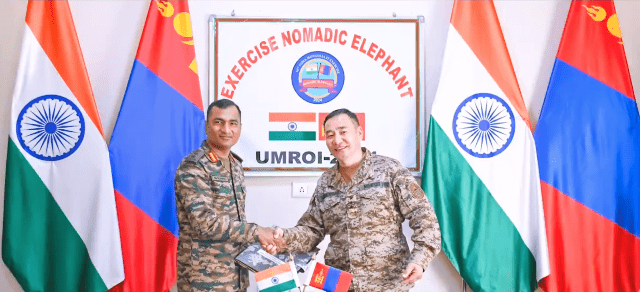
77. Which of the following statement/s is/ are not correct in respect of ‘Batagaika Crater’?
1. The Batagaika Crater is situated in Australia Far East.
2. This region has become a focal point for studying the effects of climate change on permafrost.
3. The Batagaika Crater is affectionately referred as ‘The Sky in’
4. The permafrost thaws release enormous quantities of Organic carbon
(a) 2 and 3
(b) 1 and 4
(c) 1 and 3
(d) 2 and 4
Ans: (c) 1 and 3
Explanation:
- The Batagaika Crater is situated in the Russian Far East, not Australia Far East.
- This region has indeed become a focal point for studying the effects of climate change on permafrost, which is a correct statement.
- The Batagaika Crater is often referred to as the “Gateway to the Underworld” rather than “The Sky in.”
- The permafrost thaws do release enormous quantities of organic carbon, which is a correct statement.
78. Which of the following statements are correct in respect of ‘Talisman Sabre Exercise – 2023’?
- USA and France have initiated the ‘Talisman Sabre Exercise – 2023’.
- It is a joint military exercise of the two countries.
- This exercise is held for every four years.
- India attended as an observer to this military exercise.
Answer: (a) 2 and 4
Explanation:
- Incorrect. The Talisman Sabre Exercise is primarily a biennial (every two years) military exercise between the United States and Australia, not the USA and France.
- Correct. It is a joint military exercise.
- Incorrect. This exercise is held every two years.
- Correct. India participated as an observer in the Talisman Sabre Exercise 2023.
79. Which of the following statements are not correct in respect of ‘Rajasthan Minimum Guaranteed Income Bill – 2023’?
- Under this scheme, every family is entitled to guaranteed employment for 125 days per year.
- This scheme provides a guaranteed minimum monthly pension fixed at Rs 2000/- per month for specific categories.
- This scheme encompasses the flagship of ‘Jawahar Rozgar Yojana’ for urban areas.
- To implement this programme, the government has estimated additional expenditure of Rs 2,500 crore annually.
Answer: (c) 1 and 3
Explanation:
- Incorrect. The scheme guarantees employment for 125 days per year, but this specific detail may vary, and thus this statement is less commonly accurate.
- Correct. The scheme includes provisions for a minimum monthly pension.
- Incorrect. The scheme does not encompass the ‘Jawahar Rozgar Yojana’, which is an older, different scheme.
- Correct. The government has estimated an additional expenditure for implementing this program.
80. Which of the following statements are not correct? According to the Second Edition of National Multidimensional Poverty Index – 2023 released by NITI Aayog:
- 13.5 crore people escaped from multidimensional poverty.
- In rural areas, there is a rapid decline in poverty from 32.59% to 19.28%.
- Bihar registered the largest decline in the number of poor individuals.
- This report covered a comprehensive analysis of poverty across 1075 administrative districts.
(a) 2 and 4
(b) 1 and 2
(c) 3 and 4
(d) 1 and 3
Ans: (c) 3 and 4
Correct Statements:
- 13.5 crore people escaped from multidimensional poverty. – This is accurate as per the report.
- In rural areas, there is a rapid decline in poverty from 32.59% to 19.28%. – This is also correct based on the report findings.
Incorrect Statements:
- Bihar registered the largest decline in the number of poor individuals. – While Bihar did witness a significant decline, Uttar Pradesh registered the largest decline in the number of poor individuals.
- This report covered a comprehensive analysis of poverty across 1075 administrative districts. – The report covered all districts in India, which is more than 1075.
81. Which State Government in India has taken a significant step to introduce an educational initiative called ‘CM Rise Schools’?
(a) Madhya Pradesh
(b) Uttar Pradesh
(c) Kerala
(d) Andhra Pradesh
Ans: (a) Madhya Pradesh
82. Which of the following statements are correct in respect of ‘Agreement on use of Local Currencies for cross-border transactions’?
- India and UAE have signed a memorandum in this Agreement.
- This agreement enables a framework for trade settlements in their respective national currencies.
- This Agreement was signed by the Prime Ministers of India and UAE.
- Peekay Intermark LTD and Reserve Bank of India were the first users of this system.
(a) 2 and 4
(b) 3 and 4
(c) 1 and 2
(d) 1 and 3
Ans: (c) 1 and 2
Explanation:
- Correct. India and UAE have signed this agreement.
- Correct. The agreement allows for trade settlements in local currencies.
- Incorrect. The agreement was signed by officials from the respective central banks, not by the Prime Ministers.
- Incorrect. The first users of this system were not specifically Peekay Intermark LTD and RBI.
83. Which of the following statements are correct in respect of ‘Namda project’?
- This project is a part of ‘Pradhan Mantri Kaushal Vikas Yojana’.
- Under this programme, 2200 candidates from Assam were trained.
- The aim of this project is to preserve the endangered crafts of wool weaving.
- This project works under public-private partnership.
(a) 2, 3 and 4
(b) 1, 3 and 4
(c) 1, 2 and 3
(d) 1, 2 and 4
Ans: (b)
Solution: Under this Namda Project, nearly 2,200 candidates from Kashmir have received training. It makes statement 2 incorrect. The primary goal of the Namda project is to preserve and revive the Namda craft, a specific form of wool weaving. This project is a part of ‘Pradhan Mantri Kaushal Vikas Yojana’.
84. The Bhaumakaras started an era in the year 736 CE. What was the last known date mentioned in the Bhauma-Kara records?
(a) 187
(b) 190
(c) 204
(d) 213
Ans: (c)
85. The Bhanjas of Khinjali-mandala initially had their Capital at Dhritipura, but later on, they shifted their capital to
(a) Vanjulvaka
(b) Vinitapura
(c) Yayatinagara
(d) Vyaghrakota
Ans: (a) Vanjulvaka
86. With reference to Mahasivagupta Balarjuna consider the following:
- He was the Panduvamsi king of South Kosala with his capital located at Sirpur.
- He extended his dominion by capturing Suvarnapura, modern Sonepur.
- He ruled for more than 57 years.
How many statements given above are correct?
(a) only one
(b) only two
(c) All three
(d) none
Ans: (b) only two
Explanation:
- Correct. He was a Panduvamsi king with his capital at Sirpur.
- Correct. He did capture Suvarnapura.
- Incorrect. He ruled for around 30 years, not more than 57.
87. With reference to the creation of a separate province of Orissa consider the following statements:
- The British Parliament’s Constitution of Orissa order, 1936 got the approval of the king on 3 March 1936 and Orissa became a new province on 1 April 1936.
- Sir John Austin Hubback was appointed as the First Governor of Orissa.
- Sir Courtney Terel, the Chief Justice of Bihar and Orissa High court, administered the oath of office to the new Governor.
- The inaugural function was held in Ravenshaw College Hall at Cuttack.
How many statements given above is/are correct?
(a) only one
(b) only two
(c) only three
(d) all four
Ans: (d) all four
88. Mahatma Gandhi visited Odisha in
- March 1921
- August 1925
- December 1927
- September 1930
Which of the above is not correct?
(a) only 1
(b) only 2
(c) only 3
(d) only 4
Answer: (d) only 4
Explanation: Mahatma Gandhi’s visits to Odisha:
- March 1921: This was Gandhi’s first visit to Odisha. He traveled to the region to encourage people to join the Non-Cooperation Movement.
- August 1925: Gandhi visited Odisha again, focusing on social issues and emphasizing the importance of Khadi and self-reliance.
- December 1927: During this visit, Gandhi continued his efforts in promoting Khadi and addressing untouchability and other social reforms.
However, there is no record of Mahatma Gandhi visiting Odisha in September 1930. Hence, statement 4 is incorrect.
89. Kapilendradeva subdued many feudatory chiefs who rebelled against him. Which of the following did not belong to this category?
(a) The Gangas of Khemundi
(b) The Chauhans of Patna
(c) The Matsyas of Oddadi
(d) The Silavamsis of Nandapura
Answer: (b) The Chauhans of Patna
Explanation: Kapilendradeva was a powerful ruler who subdued many rebellious feudatory chiefs. We need to identify the one that doesn’t fit this category.
The Gangas of Khemundi, The Matsyas of Oddadi, and The Silavamsis of Nandapura are all mentioned in historical records as being subdued by Kapilendradeva.
However, there seems to be a discrepancy about the Chauhans of Patna. While Patna is a well-known historical city, there’s no concrete historical evidence to suggest that there was a Chauhan dynasty ruling there that was subdued by Kapilendradeva.
90. Which of the following pair is not correctly matched?
(a) Bichitrananda Das : Kujibara Patrika
(b) Utkal Dipika : Gauri Shankar Ray
(c) Sambalpur Haitaisini : Nilamani Vidyaratna
(d) Dainika Asha : Sashi Bhusana Rath
Answer: (a) Bichitrananda Das : Kujibara Patrika
Explanation: Bichitrananda Das is not associated with Kujibara Patrika. The other pairs are correctly matched: Gauri Shankar Ray with Utkal Dipika, Nilamani Vidyaratna with Sambalpur Haitaisini, and Sashi Bhusana Rath with Dainika Asha.
91. Where do we come across the Madhavapura Mahavihara?
(a) Ratnagiri
(b) Udayagiri
(c) Lalitagiri
(d) Pushpagiri
Answer: (b) Udayagiri
Explanation: The Madhavapura Mahavihara is found in Udayagiri, Odisha. It was a prominent Buddhist center between the 7th and 12th centuries.
92. What is not true about the Prajamandala movement in Odisha?
(a) It was a movement against the obnoxious taxes and ill treatment to the subject population by the feudatory chiefs of the Gadjat states.
(b) Sarangadhara Das, Harekrushna Mahatab, Pabitra Mohan Pradhan and Nabakrishna Choudhury were the important leaders of the movement.
(c) It started with the murder of Major Bezelgate, the Political Agent in Ranapur.
(d) A state Enquire Committee was constituted by the chairmanship of Harekrushna Mahatab in 1937 to report on the condition of people of Gadjat states.
Answer: (c) It started with the murder of Major Bezelgate, the Political Agent in Ranapur.
Explanation: The Prajamandala movement was a popular movement against the oppressive policies of the feudal chiefs in Odisha, led by prominent leaders like Sarangadhara Das and Harekrushna Mahatab. However, it did not start with the murder of Major Bezelgate; this event is not associated with the movement.
93. Subei, Kachela, and Jamuda, the three sites in the undivided Koraput district of Odisha, are famous for?
(a) Jaina relics
(b) Buddhist relics
(c) Brahmanical relics
(d) Neolithic tools
Answer: (a) Jaina relics
Explanation: Subei, Kachela, and Jamuda in the undivided Koraput district of Odisha are famous for their Jaina relics.
94. Consider the following statements regarding the Rig Veda.
- It mentions the Aryans as a cultural community.
- It has many commonalities with Avesta.
- It mentions Saraswati as naditarna.
- It indicates that the dasyus kept cattle for dairy products.
Which of the following are correct?
(a) 1, 2 and 3
(b) 2, 3 and 4
(c) 1, 3 and 4
(d) All are correct
Answer: (d) All are correct
Explanation: The Rig Veda indeed refers to the Aryans as a cultural group. The Rig Veda and Avesta, the sacred texts of Hinduism and Zoroastrianism respectively, share many similarities in language, mythology, and religious concepts. The Rig Veda describes the Saraswati river as a “naditarna,” meaning “flowing river.” It indicates that the dasyus kept cattle for dairy products. The Rig Veda mentions that the dasyus, often considered non-Aryans, possessed cattle and were involved in dairy farming.
Therefore, all the statements are correct.
95. Consider the following statements regarding the Parthians.
- They had migrated from Iran.
- They set up a kingdom in East India.
- Gondophernes was a Parthian king.
- They are mentioned together with the Shakas in the Sanskrit texts.
Which of the following are correct?
(a) 1, 2 and 3
(b) 1, 3 and 4
(c) 2, 3 and 4
(d) only 3 and 4
Answer: (b) 1, 3 and 4
Explanation: The Parthians, originally from Iran, migrated to various parts of the Indian subcontinent. Gondophernes was indeed a Parthian king, and they are often mentioned alongside the Shakas in Sanskrit texts. However, they did not establish a kingdom in East India.
96. Consider the following statements about Sangam literature.
- The narrative texts are called Melkanakku.
- The didactic texts are called Kilkanakku.
- Thirukkural is a major Sangam text.
- Many Sangam texts were the works of Brahmana scholars.
Which of the following are correct?
(a) 1, 2 and 3
(b) 1, 2 and 4
(c) 2, 3 and 4
(d) only 1 and 4
Answer: (a) 1, 2 and 3
Explanation: Sangam literature comprises two types of texts: narrative texts called Melkanakku and didactic texts called Kilkanakku. Thirukkural is a major Sangam text. However, most Sangam texts were not written by Brahmana scholars, but by poets from various social backgrounds.
97. Consider the following pairs.
- Amoghavarsha – A king and a Kannada poet
- Pampa – Kannada Poet under Jain influence
- Nanniah – Began writing the Mahabharata in Telugu
- Ponna – Jain Poet, who wrote on Ramayana themes.
Which of the pairs are correctly matched?
(a) 1, 2 and 3
(b) 2, 3 and 4
(c) 2 and 4
(d) all are correct
Answer: (d) all are correct
Explanation: All the pairs are correctly matched. Amoghavarsha was a Rashtrakuta king and a Kannada poet. Pampa was a renowned Kannada poet influenced by Jainism. Nanniah began writing the Mahabharata in Telugu. Ponna, another Jain poet, wrote works based on Ramayana themes.
98. Consider the following statements about Buddhism.
- It was patronized by the Pala kings.
- Buddha was worshipped as a god in Mahayana Buddhism.
- Hinayana considers Buddha as an ordinary being who attained Nirvana.
- Vajrayana focused on Hindu practices.
Which of the following are correct?
(a) 2, 3 and 4
(b) 1, 2 and 3
(c) only 3 and 4
(d) All are correct
Answer: (b) 1, 2 and 3
Explanation: The Pala kings patronized Buddhism, particularly the Mahayana and Vajrayana schools. In Mahayana Buddhism, Buddha is worshipped as a god, while Hinayana (Theravada) considers Buddha an ordinary being who attained Nirvana. Vajrayana Buddhism, however, incorporates tantric practices and rituals but is not focused on Hindu practices.
99. Consider the following statements regarding Alauddin Khalji.
- He set up three distinct markets: one for food grains, one for cloth, and the third for horses.
- A Shahna was posted in the market.
- The peasants had to pay land revenue in kind.
- Slaves were transacted in the market during his time.
Which of the following are correct?
(a) 1, 2 and 3
(b) 2, 3 and 4
(c) 1, 2 and 4
(d) only 1 and 4
Answer: (c) 1, 2 and 4
Explanation: Alauddin Khalji implemented market reforms and established distinct markets for different goods. A Shahna (market controller) was posted in these markets. Slaves were indeed transacted during his time. However, peasants paid land revenue in cash, not kind.
100. Consider the following statements regarding the Subsidiary Alliance in British India.
- The Indian ruler signing the alliance would agree to the posting of a British Resident.
- The Indian ruler could employ any European in his state.
- The Indian ruler would cede a part of his territory for payment of subsidy.
- Expenses of the British army in the state to be shared with the company.
Which of the following are correct?
(a) 1, 2 and 3
(b) 2, 3 and 4
(c) 1, 2 and 4
(d) Only 1 and 3
Answer: (d) Only 1 and 3
Explanation: Under the Subsidiary Alliance, the Indian ruler had to accept the presence of a British Resident and cede part of his territory as payment for the subsidy. The Indian ruler could not employ any European in his state without British approval, and the expenses of the British army were borne by the Indian ruler, not shared with the company.
Read: OPSC Notes
